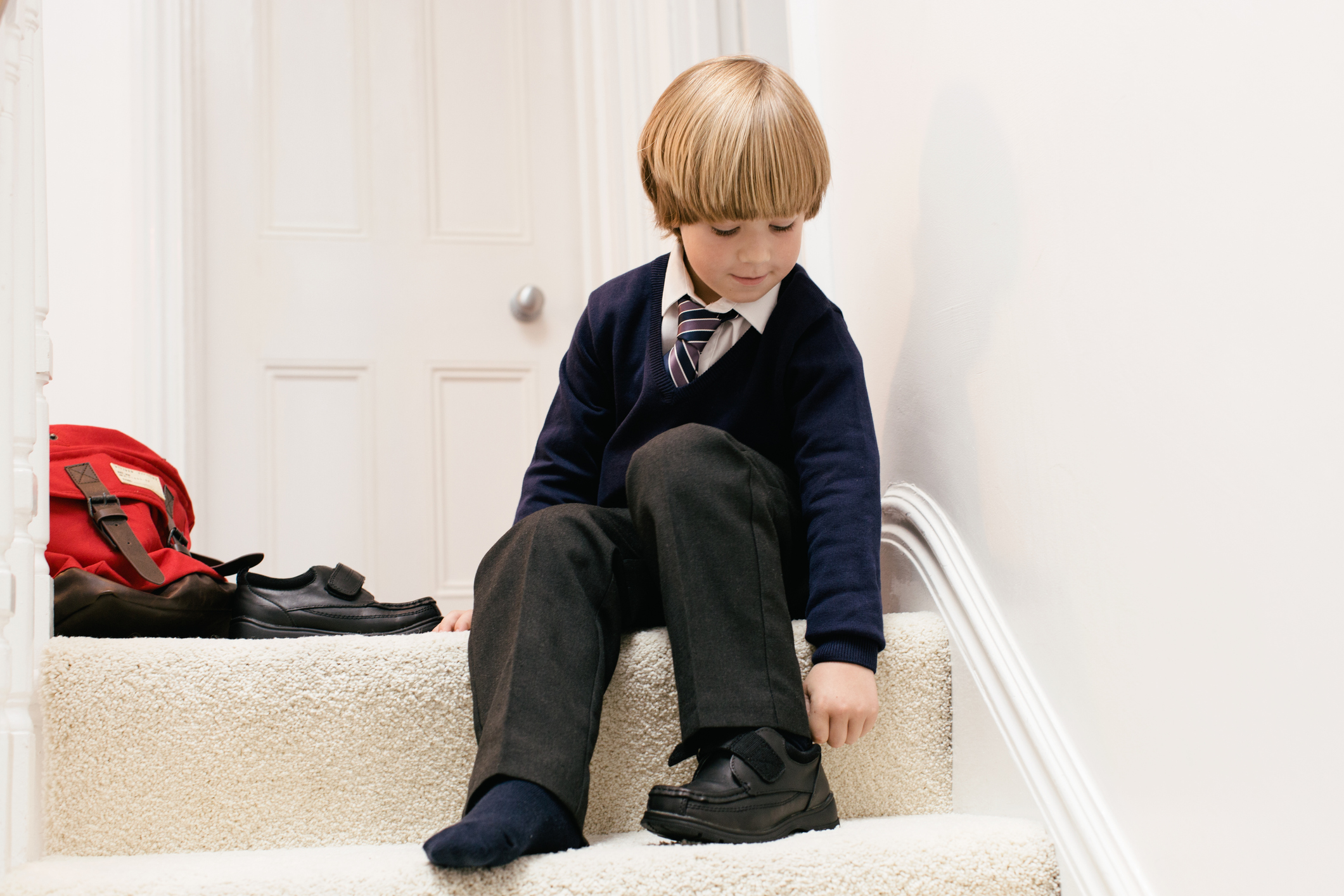What are school uniform grants, who can get them and how much does it pay?
School uniform grants could offer valuable financial support, but you’ll need to qualify first, as we explain.

Sarah Handley

This article has been updated to reflect the latest research when it comes to school uniform costs. We have also checked that the school uniform grant figures and application deadlines are accurate, updating where necessary.
School uniform grants could help alleviate financial pressure on family budgets, we explain how they work, how much you could get and how you qualify.
Back to school purchases can be expensive, with the average cost of compulsory secondary school uniform and sportswear items coming in at £92.35 per pupil, according to 2024 figures from The Schoolwear Association. But applying for a school uniform grant could be one way to save money on back to school costs and keep your bank balance a little healthier.
Marie-Elise Worswick, co-founder of Tayberry Tuition & Consultancy, told us: “It's really important that families are fully aware of what they're entitled to as their children head back to school or start at a new school in the autumn... School uniforms in particular are one area which can be very expensive, so it's always worth checking to see if you're eligible to apply for the school uniform grant.”
What are school uniform grants?
School uniform grants are an amount of money you can get from your local council, if you are on a low income, to put towards the cost of school uniforms and PE kits.
Andrea Knowles, budgeting expert at vouchers.co.uk, explains: “The school uniform grant is a government-run scheme which was introduced to help low-income families purchase school uniforms for their children. The grant is non-repayable and has a maximum amount of £200, however, this depends on your local authority and individual circumstances.”
Local authorities in Northern Ireland, Wales and Scotland must offer the scheme, so you should be able to get help if you qualify. However, there is no requirement for local authorities in England to offer school uniform grants, so whether you’ll be able to get one will depend on your local council.
You can find out whether your local authority offers the grant by using the government’s handy tool on the gov.uk website. Simply enter your postcode and click through to your local authority’s website.
Parenting advice, hot topics, best buys and family finance tips delivered straight to your inbox.
Who can get a school uniform grant?
As long as your local authority offers a school uniform grant, your child will usually qualify if they are eligible for free school meals. This means you will need to be receiving at least one of the following means-tested benefits:
- Child Tax Credit
- Income Support
- Income-based Jobseeker’s Allowance
- Income-related Employment and Support Allowance
- Support under Part VI of the Immigration and Asylum Act 1999
- The ‘guaranteed element’ of Pension Credit
- Universal Credit
- Working Tax Credit run-on – paid for four weeks after you stop qualifying for Working Tax Credit
It’s worth noting, however, that if your child goes to a private or independently run school, you won’t be eligible for the school uniform grant.
How much could you get with a school uniform grant?
The amount of money you’ll get with a school uniform grant - provided you qualify and your local authority offers it - will vary depending on the local authority and where you live in the UK.
In England, the maximum you can get is £170 per child, but it could be as little as £25.
In Northern Ireland, the clothing allowance scheme could give you:
- £42.90 for a primary school pupil
- £87.60 for a post primary/special school pupil under 15 years old
- £93.60 for a post primary/special school pupil over 15 years old
In Scotland, where it’s known as the school clothing grant, everyone who qualifies will get at least:
- £120 per child of primary school age
- £150 per child of secondary school age
In Wales, the grant is known as the pupil development grant, and you can usually get £125 per pupil, rising to £200 for those pupils in Year 7 to cover the additional costs of starting secondary school.
Councils will usually pay the grant in the form of a cheque, although in Scotland it is typically paid directly into your bank account. Most payments are made in July or August before the new school year starts, though this will depend on the council. On average it’s around 10 to 15 working days after you’ve submitted your application.

How do you apply for a school uniform grant?
You’ll need to apply for the school uniform grant through your local council’s website. If you need help with this, the gov.uk, gov.wales, mygov.scot and nidirect.gov.uk websites can point you in the right direction.
Deadlines to apply for a grant in England will vary depending on the council. In Wales, you can apply for the 2024-25 year until 31 May 2025, while in Scotland, most councils accept applications from July until the end of March, but it’s worth checking your local council’s website to be sure. In Northern Ireland you must now register and create an account before you can apply.
“When applying, you’ll need proof of address (such as a utility bill or council tax statement), proof of identity (a driver’s licence or passport), and proof of guardianship of your child (birth certificate or adoption papers),” explains Andrea Knowles. “You’ll also need a recent bank statement that proves your income or confirms that you are receiving one of the benefits required for eligibility. Alternatively, you can bring a letter from the Department for Work and Pensions.”
If your local council doesn’t offer a school uniform grant, it is worth contacting your school directly to see if they offer any financial support. Some, for example, might offer vouchers towards the cost of uniforms or they might hold second-hand school uniform sales.
It’s also worth taking a look at the turn2us grants tool to see whether you’re eligible for any charitable grants that could help you with costs.
Other ways to save on school uniforms
If you don’t qualify or cannot get a school uniform grant, the good news is there are many other ways to save money on school uniform costs.
Buying a uniform second-hand is one of the easiest ways to save money. Phoebe Ellis, consumer champion at Thrive Money, told us: “Apps like Uniformd are essentially an online marketplace for schools to sell donated uniforms year round to parents, with the funds going directly back into the school. All you need to do is simply go onto the app, find the uniform you require, purchase your clothes for a fraction of the price of new, and head to the school to collect it.”
Other sites to look at include oldschooluniform.co.uk and uniformerly.co.uk, plus you could try Facebook Marketplace or eBay, or even local charity shops.

Under new guidance from the Department for Education (DfE), schools in England must now ensure that second-hand uniforms are available. They are also advised to keep branded uniform items to a minimum and encourage parents to buy cheaper supermarket alternatives, which could save parents around £50 on average.
Abigail Yearley from TopCashback.co.uk says: “All the big supermarkets tend to run back-to-school events during the summer months, all with various claims and money-back promises. Make sure you keep an eye out for those and look at the guarantees as well as the pricing.
“It is especially worth checking out discount supermarkets like Aldi as their back-to-school events are known for bargain prices, but stock does tend to get snapped up very quickly.”
Check out the M&S school uniform sale, as well as supermarkets like Tesco, Sainsbury's, and Asda for great prices on uniform essentials.
Another option is to speak to other parents at pick up or drop off time, or via any WhatsApp groups you’re on, to see if you could swap certain uniform items. Ceri Gillett, founder and CEO of Mubo, says: “So many people are utilising uniform swap shops these days and it is a really sustainable way of kitting your kids out with essentials that they need for a specific school without spending a penny. So help your bank balance and do your bit for sustainability and look into uniform swaps near you and if there isn’t one, consider setting up a Facebook group or similar to get that started.”
You might also be interested in research that suggests primary school costs parents £6,000 per child, and this uniform labelling hack that could save you £2,000 a year.

Mum of two, Rachel is a freelance personal finance journalist who has been writing about everything from mortgages to car insurance for over a decade. Having previously worked at Shares Magazine, where she specialised in small-cap stocks, Rachel developed a passion for consumer finance and saving money when she moved to lovemoney.com. She later spent more than 8 years as an editor at price comparison site MoneySuperMarket, often acting as spokesperson. Rachel went freelance in 2020, just as the pandemic hit, and has since written for numerous websites and national newspapers, including The Mail on Sunday, The Observer, The Sun and Forbes. She is passionate about helping families become more confident with their finances, giving them the tools they need to take control of their money and make savings. In her spare time, Rachel is a keen traveller and baker.
- Sarah HandleyMoney Editor, GoodtoKnow